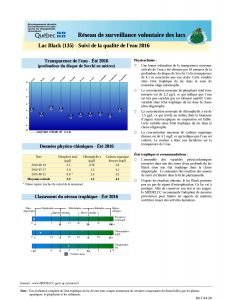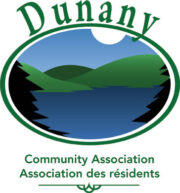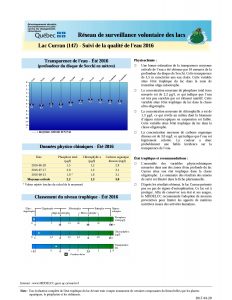Some of you might have wondered why I did not publish the lake results last spring as I have done in the previous years. Answer is simple: I did not get them till the end of June. Why?
The lab at the Environment Department hit a snag last summer. The equipment measuring the phosphorus content broke down. By the time it was replaced, the third water samples were out of date. The rest is bureaucratic snafu!
If you look at the charts carefully, you will notice an asterisk * leading to a comment that the results of the last sampling had to be taken aside because they just don’t make sense. 
Look at this 2016 Black Lake chart as an example. Click to enlarge it. The first and second phosphorus readings are 2.5 and 2.0 micro grams per litre. Excellent numbers. The third one is 0.6. Implausible!
The third column on the chart is dissolved organic carbon. This measures water coloration, in Black, it is evidently higher than in other lakes. Hence it’s name.
I have been told by the RSVL Team in Quebec City that we can really trust the first two numbers as well as those of the previous years. And now the lab has new equipment to measure phosphorus.
Let us have a look at another chart. That of Curran Lake (below).
Again, very good numbers here 1.5 and 3.0 , except for the third one (1.) that was rejected. The spread is not enormous. I saw the chart of a lake (Manitou) where it went from 1.4 to 6.9! You will also notice that transparency is much higher than in Black. Transparency champion is always Clear. Evidently!
We have ten years of data and there is great value in numbers. We have enough data to establish trends and ours is in the right direction.
You will find all the charts – 2016 and multiyear – here.
This year, we will be taking water samples in late July and August.
But remember: lakes are our main asset. Let them deteriorate and our properties could lose half of their value. That is why we insist that municipalities make sure all septic systems are in order, make sure that shoreline protection bands are there to prevent nutrients from reaching the lake. That is why we ban pesticides and fertilizers close to the lake. That is also why we insist that you wash your boats to prevent the arrival of invasive and exotic plants and molluscs that can literally kill a lake.
Sorry about the sermon! I know you will forgive me.


Thank you Jacques for the report and your good work.
Thanks for this Jacques. Good info no sermon.
As always Jacques, an important job done very well! Thank you!
It’s good news about our lakes, but we are well cautioned not to take it for granted.
A great big shout out to France and Jacques, our Lake Shepherds for all they do for our community.
And, thanks to the other volunteers who work with them to keep on top of this for us.
Thanks Jaques. Great numbers.
I will send you separately the latest issue of the Gore Express where there is a piece that answers most of your questions on this Canada wide problem.
Looks good Lets keep it good
What is the story on the caterpillar infestation?
Is it Laurentians wide? Any idea what caused it?
Is the damage to the upper growth of the deciduous
trees expected to be permanent?